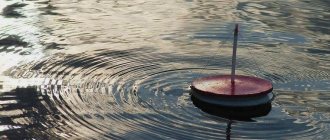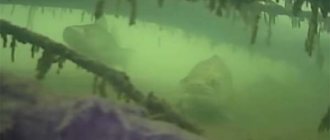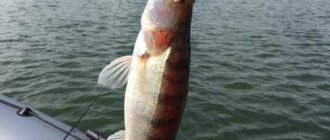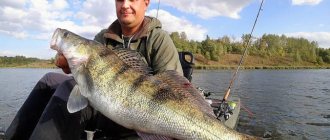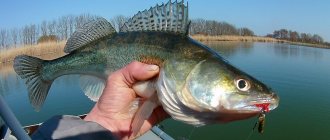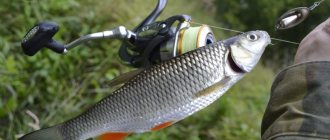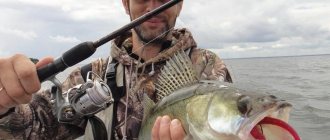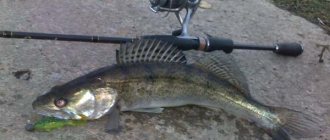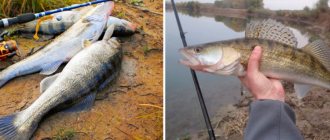Autumn fishing for pike perch is liked by many fans of spinning fishing for its prey and the relative consistency of the bite. The predator, which becomes more active as the water cools, switches to increased feeding and at this point in its behavior becomes easy prey for the fisherman. To do this, the spinner just needs to familiarize himself with the specifics of catching pike perch in the fall, relying on knowledge of its habitats, and use a simple arsenal of baits and tackle, similar in their parameters to the equipment for catching fanged fish during the rest of the open water season.
In addition to spinning and trolling, autumn fishing for pike perch can also be carried out using live bait on both donks and girders, but the popularity of these methods has recently begun to decline, and this is directly related to the spread of effective artificial baits. These methods should not be discounted either. After all, sometimes dynamic spinning fishing can be combined with more static hunting methods and at the same time significantly increase your chances of decent catches, and, of course, the resulting emotions.
Having gleaned information from the article proposed to the angler, both will become much more accessible to him and will save valuable time spent on experiments in real fishing conditions. Advice will never be superfluous, and improving the knowledge gained will help improve the results and your own confidence in the chosen fishing strategy.
Habitats
The fanged fish is a species of fish sensitive to the presence of oxygen in water. Therefore, its habitats are characterized by clean water areas and the presence of currents that promote mixing and saturation of water masses with oxygen. In rivers, the predator stays in the bottom horizons, on hard sandy or clayey soils, avoiding places of intense aquatic thickets and silt.
Fish parking areas vary in depth from 3 to 20 meters. At the bottom, schools of pike perch look for various kinds of irregularities, ledges, holes, ditches and bottom gullies and occupy these anomalies as ambush points for attack. You can catch pike perch in early autumn in snags and near trees that have fallen into the water and slow down the flow of water.
Hydrological objects, areas near dam bridges and embankments where the predator goes in search of food, are also considered promising for fishing. In the fall, fish migrations are observed following schools of bream moving to the winter roads into the deep places of rivers and lakes.
Important! It is worth considering that pike perch are not fans of coastal areas and try to stay away from coastlines in clear water.
Catching pike perch in the fall from a boat looks more attractive than coastal hunting, due to the expanded possibilities of searching for promising points and approaching them at distances convenient for fishing.
Tackle for catching pike perch in October
Both experienced and novice fishermen note that fishing for pike perch in October is most interesting and productive if you use spinning tackle in various rigging options.
Of course, the choice of fishing method will ultimately depend on the place where the fishing takes place, but still, spinning is the gear that simply must be used in October for catching pike perch. The best way to catch pike perch with a spinning rod during this period is from a boat - it’s much easier to get to its habitat this way. As for the spinning rod, it is advisable to take a fast-action rod 2.5-2.7 meters long with a dough of no more than forty grams.
Depending on which place is chosen for catching pike perch in October, rotating spoons and wobblers with appropriate depth are used. Various jig baits and foam fish are also widely used, which are sometimes much more effective than the most expensive wobblers.
Peculiarities of pike perch behavior in autumn
Catching pike perch in the fall is based on the diversity of fish behavior in the first and second part of the season. If the so-called summer-autumn period from September to mid-October is no different from preparing a fishing strategy in the summer, then the following October and the entire November, autumn-winter time, radically change fishing tactics. This radical change is associated with the beginning of increased winter migration of the predator for carp fish species, which migrate to wintering pits for the entire freeze-up period.
Fishing in September is carried out at stationary anchorage points for pike perch, which at this time are motionless and occupy secluded attack areas, obtaining food in ambush hunting mode. The increased movement of bream forces schools of pike perch to leave their homes and move to the deepest waters of the reservoir, where fishing on the edges of the holes becomes most successful in November.
Best time to fish
September zander fishing is practically no different in terms of bite intensity from fishing in the summer months. In relatively warm waters there are still enough available food items and the predator is picky in their choice. Hunting trips are carried out at night, when fishing is carried out from evening twilight until dawn. Quiet moonlit nights with increased atmospheric pressure activate pike perch to come out frequently. During the day, bites are very rare, and the pecked specimens do not differ in industrial size.
Fishing in October becomes much more interesting, and this autumn month is considered the most productive time for hunting fanged predators. The bite in October is stable both in the dark and on cloudy days. The decline in fish activity is only affected by prolonged rains and inclement weather with strong northern and northeastern wind directions. The persistence of calm and cloudy weather for two to three days brings the fanged fish to the level of gluttony, often bringing particularly trophy, well-fed individuals into the catch.
The November weather forces the predator to go to warmer waters in the pits, where at great depths the fish are active throughout the day, going out to prey periodically, at certain intervals, which is very similar to the behavior of pike, which is more popular among anglers. According to this principle of their activity, pike perch will peck until freeze-up.
Secrets of shore fishing
Since pike perch is considered cautious and timid, spinning anglers should not come close to the shoreline. The first casts are made close enough to explore the adjacent water area. If the fish has not made itself known, then you can come closer to the water. After this, it is necessary to begin studying remote sections of the river. The cast is made perpendicular to the direction of the current. As the fishing line is reeled in, the equipment is demolished. This feature must be taken into account so that the bait does not end up in snags or grass. Success in river fishing from the shore largely depends on the length of the path traveled by the fisherman. Sometimes a spinner must travel more than one kilometer before a fattening fish is discovered. But the pleasure from active biting will be compensation for the wasted effort and energy. Walleye fishing can be fun and exciting. Even beginners can catch the fanged robber. But fishing will bring pleasure only if you properly equip your spinning rod, select a catchable bait and accurately deliver it to a promising place in the reservoir.
Video about catching pike perch using a spinning rod:
Video about catching pike perch with modern baits:
A trophy specimen of pike perch can be an excellent reward for every angler, from beginner to professional. In October, pike perch reaches its largest size, and at the same time its activity remains the same. The predator actively moves around the reservoir in search of a place for wintering, systematically moving away from the shore and settling in deeper areas of the reservoir. What habits of pike perch in mid-autumn should a fisherman know about and how to organize effective fishing?
What to use to catch pike perch in the fall
The bait for pike perch in the autumn is either live bait or an artificial imitation fish or worm. They try to catch live bait in the same body of water where they hunt for fanged fish. With fish that are familiar in appearance and are regularly included in the predator’s diet, there is much more hope for bites than with super-active strangers.
Important! Bleak is considered a classic live bait, although pike perch successfully attack gudgeon and roach (read more about catching pike perch with live bait).
In some regions, fishing is carried out for ruffe and small perch, and in river areas with backwaters and oxbow lakes adjacent to the riverbed, loach is successful on live bait gear. The class of catchable baits among artificial imitations includes silicone vibrotails, worms and slugs; the fanged one is especially fond of the shape in the form of a long centipede. Foam rubber fish without their own game are rightfully called purely pike-perch bait.
Important! What makes foam rubber more attractive is the impregnation of the nozzle material with attractants based on fish oil.
The most suitable wobblers for walleye fishing are minnows and some types of shad. Minnows work on twitching, but shad are more specialized for catching pike perch by trolling.
Important! Wobblers, regardless of their appearance, are chosen with noise chambers, to which the predator responds much faster, especially when trolling at depths of over 7–10 meters.
Spoons are also considered promising pike perch baits. In the fall, spinners are significantly inferior to oscillating tools, since fishing is mostly carried out in deep areas of reservoirs. But castmaster-type spinners and spinners in narrow, purlin-shaped shapes are a success among fanged fish. Recently, anglers are increasingly using luminous spoons with a fluorescent coating or with a light diode powered by a miniature battery to fish holes.
A lure fly on the hook of a spinner will obviously not be an unnecessary element, especially if it is selected in a bright red color and does not get wet synthetic plumage. With a low intensity of bites in the absence of a fly, you can safely experiment with reattaching ordinary synthetic thread to the hooks, still in the same red color. Sometimes this trick significantly changes the course of a seemingly hopeless fishing trip.
Places to catch pike perch in the fall using spinning rods
In all reservoirs, during the autumn period, the fish remains true to itself and hunts in its typical places. The main areas for fishing for pike perch are:
- Pits and returns with a hard bottom.
- Channel dumps and deep rifts.
- Sharp edges and coastal slopes.
- Snags.
- Bridge supports and other hydraulic structures.
Pike perch can be caught using spinning rods in the fall in the indicated places. Now, as in summer, the fish do not go to shallow riffles and spits, and less often rise to the upper layers of water.
You will be very lucky if the angler finds a single submerged tree trunk on the riverbed. Here you can count on a bite of trophy pike perch. In dense snags there are usually small or medium-sized zander, but weighty specimens can stand nearby on a deep dump or in a ditch with an uneven bottom.
How to catch pike perch in the fall
Gear for catching pike perch in the fall is identical to equipment for open water hunting in other seasons. The methods themselves can be divided according to the type of bait used. Artificial lures are fished using spinning rods using various fishing techniques. Among them, the most notable are jig and drop-shot, where the main role is played by silicones, twitching, when the fishing tool is a minnow-type wobbler, casting fishing using spinners, and trolling fishing, when deep-sea wobblers in the form of shad and crank are used. Foam rubber baits are used to catch pike perch both with jigs and using twitching retrieves. To carry out fishing, fast or semi-fast spinning rods are selected, with the help of which you can quickly respond to a bite, carrying out high-quality detection of the pecked fish.
A bony pike perch is unlikely to be pierced by a hook when using a slow rod action, which must be taken into account when assembling the tackle. Spinning tests depend on the weight of the bait. Zander spinning fishing, as a rule, fits into the test form from 15 to 50 grams. Braided cord is used in diameters from 0.15 to 0.25 mm. Inertia-free reel 1500–2500, with the ability to configure different levels of clutch operation. Leashes are not used when fishing for fanged fish. Water areas are fished for live bait using bottom gear. Tackle is assembled on the basis of a feeder or spinning rod, and a classic rubber band or hook is also used. Catching pike perch with a line also involves using live bait, as does the use of fry in bait hunting and circle fishing. On riffles and rapids under cliffs, using the forces of the current, pike perch are caught from a boat by trolling in a plumb line.
Catching pike perch with a jig
Jig is one of the most popular spinning fishing techniques today. Other methods of catching pike perch with a spinning rod do not bring such results.
Special gear is used for jig fishing for pike perch. The spinning rod for catching pike perch with a jig must be rigid and reliable, since this technique involves sharp cuts into the bony mouth of a fanged predator.
The standard and most popular jig wiring is the option with two turns of the reel and a pause of about 2 seconds. If the wiring does not bring any results, then it is advisable to start the wiring experiment by playing along with the rod, changing the number of revolutions and the duration of the pause.
Installations and wiring features
Silicone baits are placed in both spaced and stationary installations. Spinning fishing on currents using the drop-shot technique and a retractable leash rarely brings success. The main jig technique is considered to be step-by-step wiring with pauses of 2–3 seconds. For passive fish, it is recommended to increase the pause time and reduce the sharpness of movements. Hitting the bait on the bottom is mandatory. It has been noticed that pike perch react sensitively to the use of this technique, approaching the fishing point from longer distances.
On the contrary, the catchability of wobblers on twitching is distinguished by the sharpness of the pulls. The dotted wiring in an extended passage of the tool with a pause of 5–7 seconds, although in practice it is crude, is distinguished by its success in comparison with classic, short twitching at small stops. The wiring of foam rubber is similar to the wiring of minnow wobblers. Trolling is carried out at medium and slow speeds, often touching the bottom of the reservoir with a shad shovel. Along the same promising area of water, the surface is ironed five to seven times, tempting the predator to attack. The specificity of fishing with spoons is based on slowly pulling the fishing tool along the bottom, raising a cloud of sand or clay turbidity. After a couple of seconds of pulling, they toss the spoon 40–50 cm, with a further pause allowing the bait to naturally fall to the bottom.
Important! Almost all pike-perch bites occur during pauses, and it is at this moment that the angler must be ready for a timely hook.
The fishing process is no different in complexity. A fanged, careless fighter who, after hooking, becomes quiet on the hook and calmly pulls himself towards the boat or shore, rarely offering worthy resistance.
Features when fishing in late autumn
Fishing for pike perch in late autumn moves exclusively to deep-sea areas, where the predator is searched for at the boundaries of the beginning of the bottom rise, fishing at various water horizons, thereby determining the school’s anchorage areas. The usual spring and summer snags and access to spits using even the best baits for pike perch will not bring results. You shouldn’t leave the place you’ve chosen for fishing after a couple of unsuccessful trips. Experienced pike perch fishermen recommend experimenting with retrieves, increasing pauses and reducing the sharpness of bait movements, thereby selecting the rhythm of the game, which is to the liking of a passive, but still feeding predator.
